Based on a 2012 study conducted by the United Nation’s Environment Programme (UNEP), “poisoning from industrial and agricultural chemicals are among the top five leading causes of death worldwide, contributing to over one million deaths annually.”
In taking this revelation seriously, Guyana has been making proactive moves through its Ministry of Agriculture’s Pesticides and Toxic Chemicals Control Board to reduce such an impact here and, at the same time, help to arrest the haemorrhaging of the country’s finances. Pesticides poisoning is said to be extremely costly, both in human terms and economically.
According to information released by the Pesticides Board, pesticides and their containers pose severe risks to human health and the environment. But despite this fact it is evident that many persons do not always realise how dangerous used pesticide containers can be.
The body is leading efforts in the Caribbean to address the disposal of empty pesticide containers. This, the body said in a public announcement, is in an effort to reduce the risk to human health and the environment.
Moreover, Guyana is one of the 11 Caribbean countries participating in a project titled ‘Disposal of Obsolete Pesticides including POPs, Promotion of Alternatives and Strengthening Pesticides Management in the Caribbean’ which started in 2013.
The project is one that is supported by the UN Food and Agriculture Organisation (FAO) and the Global Environment Fund (GEF). Through the Control Board, Guyana is moving to develop an empty pesticides container management programme and will, therefore, be conducting a baseline survey. This initiative is aimed at understanding current disposal practices by local farmers.
It is expected that this survey will also provide information about the types of containers people use and what they do with them.
The survey will be conducted in the farming communities of Ruby, Parika, and the Naamryk, East Bank Essequibo. This is important since Pesticide officials have found that some farmers often burn, bury, or discard of pesticide containers in fields and trenches where they could be picked up by children or contaminate waterways. This also poses the potential of families even re-using these containers to carry water or foodstuffs which is extremely dangerous, the Control Board has noted.
As such, the baseline survey will facilitate discussions with local communities and waste disposal collectors companies for further development of an empty pesticides container management programme.
In the meantime, the Control Board has advised, “Triple rinsing and puncturing containers can massively reduce the risks…It is essential that pesticides users rinse containers three times immediately after use to prevent the pesticides from drying and adhering to the containers.” The contaminated liquid from washing the containers, the Board has advised too, should be put back into the sprayer. Added to this, the rinsed containers should be punctured to prevent them from being re-used.
Guyana is currently one of the few project countries embarking on this sound chemicals management initiative to tackle risks from pesticides and empty pesticides containers.













